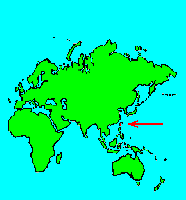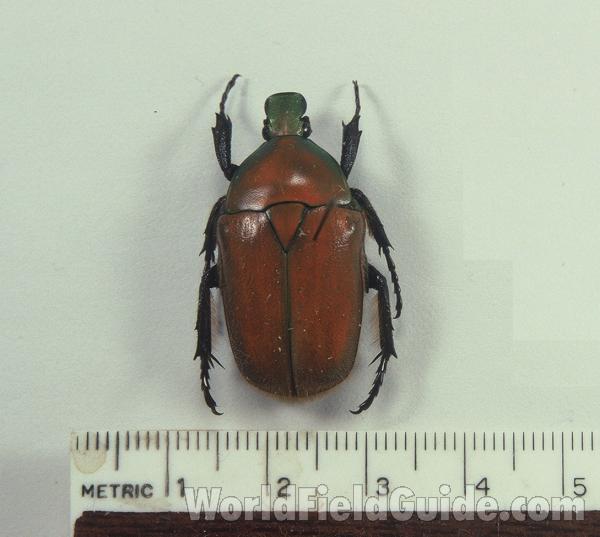SPECIES INFO
Torynorrhina pilifera is native to Taiwan. It is orange brown in color. Torynorrhina fulvopilosa has been incorrectly applied to this beetle by various insect exporters in Taiwan (formerly Formosa).Genus Pseudotorynorrhina contains the following species:
SPECIES - - - - - LOCATION
P. fortunei - China
P. fortunei nitida - Vietnam
P. japonica - Japan, Korea, China
P. japonica tonkiniana - North Vietnam
Genus Rhomborrhina is generally confined to the area from Japan through China through Malaysia and to India. Because the Taiwanese exported many, many thousands of these beetles during the l970s, most collections of worldwide exotic beetles are certain to contain several examples of this genus. The number of recognized subspecies is noted in parentheses in the following list of the species in the genus:
SPECIES - - - - - - LOCATION
R. resplendens(3) --- China to India
R. gigantea --- Sunda Islands
R. mellyi(4) --- China, India, Viet Nahm
R. gestroi --- Assam & Shillong
R. violacea --- China
R. formosana --- Taiwan
R. unicolor(2) --- Japan, China, Tibet
R. splendida --- Taiwan
R. polita --- China(?), Japan
R. jeanneli --- China
R. microcephala --- India
R. hiekei --- China
R. hamai --- Ishigaki Island(Japan)
Genus Torynorrhina is closely related to the Rhomborrhina genus. By studying the Mesosternal process on the underside of the beetle, one can separate the two genera. The Anomalocera and Pseudotorynorrhina genus are also related:
Rhomborrhina - the final plate is about as wide as long.
Torynorrhina - the final plate is much wider than long, and is about twice as large as the plate in Rhomborrhina.
The following species are found in the Torynorrhina genus:
Species - - - - - Location
T. thiemei - North Vietnam, China
T. fulvopilosa - North Vietnam, China
T. opalina - North India, Tibet
T. pilifera - Taiwan
T. hyacinthina - India to Thailand
T. flammea - Burma, China, India
T. distincta - India, China, etc.
T. apicalis - North India, Himalayan
T. laotica - Laos
T. scutellata - North Vietnam
The Trigonophorus genus is closely related to the Rhomborrhina group, but both the male and female have a small distinctive paddle at the end of their head. The following species are found in the Trigonophorus genus:
Species - - - - Location
T. nepalensis - India
T. saundersi - India
T. scintillans - Sikkim
T. gracilipes - India
T. feae - Burma
T. hookeri - India
T. rothschildi - China, Tibet
T. varians - Taiwan
T. foveiceps(Only l known) - Burma
T. yunnanus - China
Beetles (Order Coleoptera) are a diverse group of insects found throughout the world. They usually can fly and typically have four wings. Two of the wings are hardened (elytra) and serve as a body cover to protect the flying wings and abdomen. Beetles begin their life as a larvae or grub that goes through a metamorphosis that turns this worm-like creature into an adult with six legs and four wings. There probably are over 500,000 species of beetles in the world. However, that number is only conjecture as the United States does not have a complete list of its known species.
The United States has relatively few exotic beetles. However, countries like Brazil, Mexico, Ghana, Zaire, Malaysia, and Peru have many beautiful beetles.
Exotic beetles are such a fascination in Europe and Japan that they are collected much as coins are collected throughout the rest of the world.
Insects (Class Insecta) are the most successful animals on Earth if success is measured by the number of species or the total number of living organisms. This class contains more than a million species, of which North America has approximately 100,000. (Recent estimates place the number of worldwide species at four to six million.)
Insects have an exoskeleton. The body is divided into three parts. The foremost part, the head, usually bears two antennae. The middle part, the thorax, has six legs and usually four wings. The last part, the abdomen, is used for breathing and reproduction.
Although different taxonomists divide the insects differently, about thirty-five different orders are included in most of the systems.
The following abbreviated list identifies some common orders of the many different orders of insects discussed herein:
Odonata: - Dragon and Damsel Flies
Orthoptera: - Grasshoppers and Mantids
Homoptera: - Cicadas and Misc. Hoppers
Diptera: - Flies and Mosquitoes
Hymenoptera: - Ants, Wasps, and Bees
Lepidoptera: - Butterflies and Moths
Coleoptera: - Beetles
Jointed Legged Animals (Phylum Arthropoda) make up the largest phylum. There are probably more than one million different species of arthropods known to science. It is also the most successful animal phylum in terms of the total number of living organisms.
Butterflies, beetles, grasshoppers, various insects, spiders, and crabs are well-known arthropods.
The phylum is usually broken into the following five main classes:
Arachnida: - Spiders and Scorpions
Crustacea: - Crabs and Crayfish
Chilopoda: - Centipedes
Diplopoda: - Millipedes
Insecta: - Insects
There are several other "rare" classes in the arthropods that should be mentioned. A more formal list is as follows:
Sub Phylum Chelicerata
C. Arachnida: - Spiders and scorpions
C. Pycnogonida: - Sea spiders (500 species)
C. Merostomata: - Mostly fossil species
Sub Phylum Mandibulata
C. Crustacea: - Crabs and crayfish
Myriapod Group
C. Chilopoda: - Centipedes
C. Diplopoda: - Millipedes
C. Pauropoda: - Tiny millipede-like
C. Symphyla: - Garden centipedes
Insect Group
C. Insecta: - Insects
The above list does not include some extinct classes of Arthropods such as the Trilobites.
Animal Kingdom contains numerous organisms that feed on other animals or plants. Included in the animal kingdom are the lower marine invertebrates such as sponges and corals, the jointed legged animals such as insects and spiders, and the backboned animals such as fish, amphibians, reptiles, birds, and mammals.



